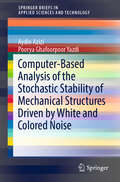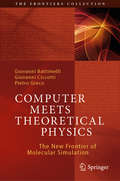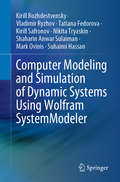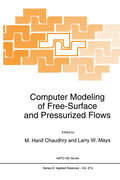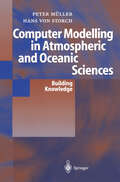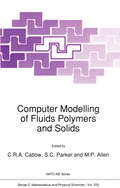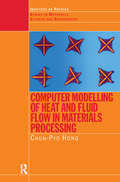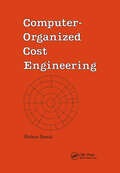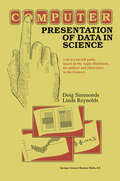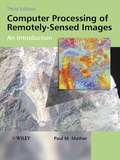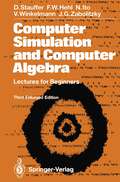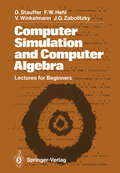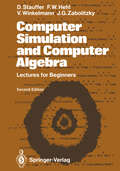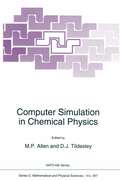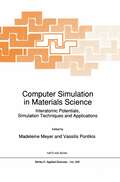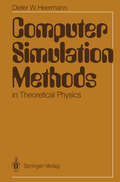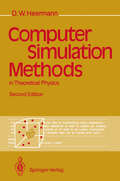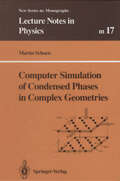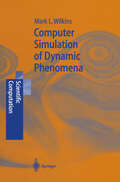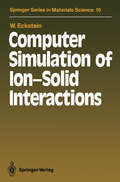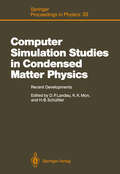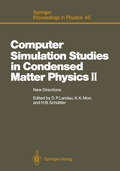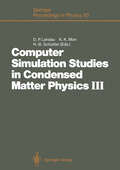- Table View
- List View
Computer-Based Analysis of the Stochastic Stability of Mechanical Structures Driven by White and Colored Noise (SpringerBriefs in Applied Sciences and Technology)
by Aydin Azizi Poorya Ghafoorpoor YazdiThis book provides a concise introduction to the behavior of mechanical structures and testing their stochastic stability under the influence of noise. It explains the physical effects of noise and in particular the concept of Gaussian white noise. In closing, the book explains how to model the effects of noise on mechanical structures, and how to nullify / compensate for it by designing effective controllers.
Computer Meets Theoretical Physics: The New Frontier of Molecular Simulation (The Frontiers Collection)
by Giovanni Battimelli Giovanni Ciccotti Pietro GrecoThis book provides a vivid account of the early history of molecular simulation, a new frontier for our understanding of matter that was opened when the demands of theoretical physicists were met by the availability of the modern computers. Since their inception, electronic computers have enormously increased their performance, thus making possible the unprecedented technological revolution that characterizes our present times. This obvious technological advancement has brought with it a silent scientific revolution in the practice of theoretical physics. In particular, in the physics of matter it has opened up a direct route from the microscopic physical laws to observable phenomena. One can now study the time evolution of systems composed of millions of molecules, and simulate the behaviour of macroscopic materials and actually predict their properties. Molecular simulation has provided a new theoretical and conceptual tool that physicists could only dream of when the foundations of statistical mechanics were laid. Molecular simulation has undergone impressive development, both in the size of the scientific community involved and in the range and scope of its applications. It has become the ubiquitous workhorse for investigating the nature of complex condensed matter systems in physics, chemistry, materials and the life sciences. Yet these developments remain largely unknown outside the inner circles of practitioners, and they have so far never been described for a wider public. The main objective of this book is therefore to offer a reasonably comprehensive reconstruction of the early history of molecular simulation addressed to an audience of both scientists and interested non-scientists, describing the scientific and personal trajectories of the main protagonists and discussing the deep conceptual innovations that their work produced.
Computer Modeling and Simulation of Dynamic Systems Using Wolfram SystemModeler
by Kirill Rozhdestvensky Vladimir Ryzhov Tatiana Fedorova Kirill Safronov Nikita Tryaskin Shaharin Anwar Sulaiman Mark Ovinis Suhaimi HassanThis book briefly discusses the main provisions of the theory of modeling. It also describes in detail the methodology for constructing computer models of dynamic systems using the Wolfram visual modeling environment, SystemModeler, and provides illustrative examples of solving problems of mechanics and hydraulics. Intended for students and professionals in the field, the book also serves as a supplement to university courses in modeling and simulation of dynamic systems.
Computer Modeling of Free-Surface and Pressurized Flows (NATO Science Series E: #274)
by M. Hanif Chaudhry L. MaysComputers are widely used for the analysis, design, and operation of water resource projects. This gives accurate results, allowing the analysis of complex systems which may not have been possible otherwise, and the investigation and comparison of several different alternatives in a short time, thereby reducing the project costs, optimizing design, and efficient utilization of resources. This volume compiles an edited version of the lecture notes specially prepared by 14 well-known European and North American researchers. Part I deals with free-surface flows. Governing equations are derived and their solution by the finite-difference, finite-element, and boundary-integral methods are discussed. Then, turbulence models, three-dimensional models, dam-break flow models, sediment transport models, and flood routing models are presented. Part II is related to the modeling of steady and transient pressurized flows. Governing equations for both single and two-component flows are derived and numerical methods for their solution are presented. The modeling of water quality in pipe networks, of cooling water systems, and slow and rapid transients is then discussed.
Computer Modelling in Atmospheric and Oceanic Sciences: Building Knowledge
by Peter K. MüllerThe book describes what these models are, what they are based on, how they function, and then, most innovatively, how they can be used to generate new useful knowledge about the environmental system. Discusses this generation of knowledge by computer models from an epistemological perspective and illustrates it by numerous examples from applied and fundamental research. Includes ample technical appendices and is a valuable source of information for graduate students and scientists alike working in the field of environmental sciences.
Computer Modelling of Fluids Polymers and Solids (Nato Science Series C: #293)
by Richard Catlow S. C. Parker M. P. AllenComputer Modelling techniques have developed very rapidly during the last decade, and interact with many contemporary scientific disciplines. One of the areas of greatest activity has concerned the modelling of condensed phases, including liquids solids and amorphous systems, where simulations have been used to provide insight into basic physical processes and in more recent years to make reliable predictions of the properties of the systems simulated. Indeed the predictive role of simulations is increasingly recognised both in academic and industrial contexts. Current active areas of application include topics as diverse as the viscosity of liquids, the conformation of proteins, the behaviour of hydrogen in metals, the diffusion of molecules in porous catalysts and the properties of micelles. This book, which is based on a NATO ASI held at the University of Bath, UK, from September 5th-17th, 1988, aims to give a general survey of this field, with detailed discussions both of methodologies and of applications. The earlier chapters of the book are devoted mainly to techniques and the later ones to recent simulation studies of fluids, polymers (including biological molecules) and solids. Special attention is paid to the role of interatomic potentials which are the fundamental physical input to simulations. In addition, developments in computer hardware are considered in depth, owing to the crucial role which such developments are playing in the expansion of the horizons of computer modelling studies.
Computer Modelling of Heat and Fluid Flow in Materials Processing
by C.P. HongThe understanding and control of transport phenomena in materials processing play an important role in the improvement of conventional processes and in the development of new techniques. Computer modeling of these phenomena can be used effectively for this purpose. Although there are several books in the literature covering the analysis of heat tra
Computer Modelling of Heat and Fluid Flow in Materials Processing
by C.P. HongThe understanding and control of transport phenomena in materials processing play an important role in the improvement of conventional processes and in the development of new techniques. Computer modeling of these phenomena can be used effectively for this purpose. Although there are several books in the literature covering the analysis of heat tra
Computer-Organized Cost Engineering
by Gideon SamidProviding a sequence of steps for matching cost engineering needs with helpful computer tools, this reference addresses the issues of project complexity and uncertainty; cost estimation, scheduling, and cost control; cost and result uncertainty; engineering and general purpose software; utilities th
Computer-Organized Cost Engineering
by Gideon SamidProviding a sequence of steps for matching cost engineering needs with helpful computer tools, this reference addresses the issues of project complexity and uncertainty; cost estimation, scheduling, and cost control; cost and result uncertainty; engineering and general purpose software; utilities th
Computer Presentation of Data in Science: a do-it-yourself guide, based on the Apple Macintosh, for authors and illustrators in the Sciences
by D. Simmonds L. ReynoldsBooks about printing written for printers or would-be printers go back over 300 years. The earliest of them were almost exclusively concerned with books; this century, however, there has been more emphasis on other kinds of documents, and particularly their design. But no shift in document production has been more sudden than the one that has happened most recently. ConSequently, the last five years have witnessed a substantial movement away from books written for professionals to ones whose aim is to help would-be authors produce their own documents. The opportunities for authors to do this have been opened up by the advent of desktop publishing (a term coined as recently as 1984). As most exponents of desktop publishing have come to realise, the term is something of a misnomer because the provision of facilities that allow authors to produce their own material for publishing is not quite the same thing as publish ing. Nevertheless, it has been useful in focussing attention on author-produced documents, and what might be described as the democratisation of document production. This book is different from others in the field. Its target audience is the busy scientist engaged in teaching or research who uses computers in the ordinary course of work. The world of scientific publishing is rapidly moving towards the day when journals will expect contributions from authors on disc, or even by direct transfer of data from the author's computer to the output device of an editor via telephone and satellite.
Computer Processing of Remotely-Sensed Images: An Introduction
by Paul M. MatherRemotely-sensed images of the Earth's surface provide a valuable source of information about the geographical distribution and properties of natural and cultural features. This fully revised and updated edition of a highly regarded textbook deals with the mechanics of processing remotely-senses images. Presented in an accessible manner, the book covers a wide range of image processing and pattern recognition techniques. Features include: New topics on LiDAR data processing, SAR interferometry, the analysis of imaging spectrometer image sets and the use of the wavelet transform. An accompanying CD-ROM with: updated MIPS software, including modules for standard procedures such as image display, filtering, image transforms, graph plotting, import of data from a range of sensors. A set of exercises, including data sets, illustrating the application of discussed methods using the MIPS software. An extensive list of WWW resources including colour illustrations for easy download. For further information, including exercises and latest software information visit the Author's Website at: http://homepage.ntlworld.com/paul.mather/ComputerProcessing3/
Computer Simulation and Computer Algebra: Lectures for Beginners
by Dietrich Stauffer Friedrich W Hehl Nobuyasu Ito Volker Winkelmann John G. ZabolitzkyComputer Simulation and Computer Algebra. Starting from simple examples in classical mechanics, these introductory lectures proceed to simulations in statistical physics (using FORTRAN) and then explain in detail the use of computer algebra (by means of Reduce). This third edition takes into account the most recent version of Reduce (3.4.1) and updates the description of large-scale simulations to subjects such as the 170000 X 170000 Ising model. Furthermore, an introduction to both vector and parallel computing is given.
Computer Simulation and Computer Algebra: Lectures for Beginners
by Dietrich Stauffer Friedrich W Hehl Volker Winkelmann John G. ZabolitzkyComputers play an increasingly important role in many of today's activities, and correspondingly physicists find employment after graduation in computer related jobs, often quite remote from their physics education. The present lectures, on the other hand, emphasize how we can use computers for the purposes of fundamental research in physics. Thus we do not deal with programs designed for newspapers, banks, or travel agencies, i.e., word processing and storage of large amounts of data. Instead, our lectures concentrate on physics problems, where the computer often has to work quite hard to get a result. Our programs are necessarily 5 quite short, excluding for example quantum chemistry programs with 10 program lines. The reader will learn how to handle computers for well-defined purposes. Therefore, in the end, this course will also enable him to orient himself in computer-related jobs. The first chapter deals mainly with solutions of the Newtonian equation of motion, that force equals mass times acceleration, which is a precursor to the molecular dynamics method in statistical physics. The second chap ter considers, by means of several examples, another method for statistical physics, Monte Carlo simulation. These two chapters deal with numbers, the traditional territory of computers. In contrast, analytic formula manipulation, 3 5 4 3 such as (a+27b -4c)5 = a + 135a b - ... , is taught in the last chapter and is important, for instance, in analytic integration or for evaluating expressions in Einstein's general theory of relativity.
Computer Simulation and Computer Algebra: Lectures for Beginners
by Dietrich Stauffer Friedrich W Hehl Volker Winkelmann John G. ZabolitzkyThe chapter on statistical-physics simulations has been enlarged, mainly by a dis cussion of multispin coding techniques for the Ising model (bit-by-bit parallel oper ations). In the chapter about Reduce, some details of the presentation have been cor rected or clarified. The new operator MATEIGEN for the computation of eigenvec tors of matrices is explained. The first chapter and the appendix remain unchanged. Needless to say, the field of computational science is advancing so quickly, for ex ample with the development of parallel, as opposed to vectorized, algorithms, that it will not be too long before a further edition is called for. Cologne, March 1989 The authors Preface to the First Edition Computers play an increasingly important role in many of today's activities, and correspondingly physicists find employment after graduation in computer related jobs, often quite remote from their physics education. The present lectures, on the other hand, emphasize how we can use computers for the purposes of fundamental research in physics. Thus we do not deal with programs designed for newspapers, banks, or travel agencies, i.e., word processing and storage of large amounts of data.
Computer Simulation in Chemical Physics (Nato Science Series C: #397)
by M. P. Allen D. J. TildesleyComputer Simulation in Chemical Physics contains the proceedings of a NATO Advanced Study Institute held at CORISA, Alghero, Sardinia, in September 1992. In the five years that have elapsed since the field was last summarized there have been a number of remarkable advances which have significantly expanded the scope of the methods. Good examples are the Car--Parrinello method, which allows the study of materials with itinerant electrons; the Gibbs technique for the direct simulation of liquid--vapor phase equilibria; the transfer of scaling concepts from simulations of spin models to more complex systems; and the development of the configurational--biased Monte-Carlo methods for studying dense polymers. The field has also been stimulated by an enormous increase in available computing power and the provision of new software. All these exciting developments, an more, are discussed in an accessible way here, making the book indispensable reading for graduate students and research scientists in both academic and industrial settings.
Computer Simulation in Materials Science: Interatomic Potentials, Simulation Techniques and Applications (NATO Science Series E: #205)
by M. Meyer Vassilis PontikisThis volume collects the contributions! to the NATO Advanced Study Institute (ASI) held in Aussois (France) by March 25 - April 5, 1991. This NATO ASI was intended to present and illustrate recent advances in computer simulation techniques applied to the study of materials science problems. Introductory lectures have been devoted to classical simulations with special reference to recent technical improvements, in view of their application to complex systems (glasses, molecular systems . . . ). Several other lectures and seminars focused on the methods of elaboration of interatomic potentials and to a critical presentation of quantum simulation techniques. On the other hand, seminars and poster sessions offered the opportunity to discuss the results of a great variety of simulation studies dealing with materials and complex systems. We hope that these proceedings will be of some help for those interested in simulations of material properties. The scientific committee advises have been of crucial importance in determining the conference program. The directors of the ASI express their gratitude to the colleagues who have participated to the committee: Y. Adda, A. Bellemans, G. BIeris, J. Castaing, C. R. A. Catlow, G. Ciccotti, J. Friedel, M. Gillan, J. P. Hansen, M. L. Klein, G. Martin, S. Nose, L. Rull-Fernandez, J. Valleau, J. Villain. The main financial support has been provided by the NATO Scientific Affairs Division and the Commission of European Communities (plan Science).
Computer Simulation Methods in Theoretical Physics
by Dieter W. HeermannAppropriately for a book having the title "Computer Simulation Methods in Theoretical Physics", this book begins with a disclai mer. It does not and cannot give a complete introduction to simu lational physics. This exciting field is too new and is expanding too rapidly for even an attempt to be made. The intention here is to present a selection of fundamental techniques that are now being widely applied in many areas of physics, mathematics, chem istry and biology. It is worth noting that the methods are not only applicable in physics. They have been successfully used in other sciences, showing their great flexibility and power. This book has two main chapters (Chaps. 3 and 4) dealing with deterministic and stochastic computer simulation methods. Under the heading "deterministic" are collected methods involving classical dynamics, i.e. classical equations of motion, which have become known as the molecular dynamics simulation method. The se cond main chapter deals with methods that are partly or entirely of a stochastic nature. These include Brownian dynamics and the Monte Carlo method. To aid understanding of the material and to develop intuition, problems are included at the end of each chapter. Upon a first reading, the reader is advised to skip Chapter 2, which is a general introduction to computer simUlation methods.
Computer Simulation Methods in Theoretical Physics
by Dieter W. HeermannComputational methods pertaining to many branches of science, such as physics, physical chemistry and biology, are presented. The text is primarily intended for third-year undergraduate or first-year graduate students. However, active researchers wanting to learn about the new techniques of computational science should also benefit from reading the book. It treats all major methods, including the powerful molecular dynamics method, Brownian dynamics and the Monte-Carlo method. All methods are treated equally from a theroetical point of view. In each case the underlying theory is presented and then practical algorithms are displayed, giving the reader the opportunity to apply these methods directly. For this purpose exercises are included. The book also features complete program listings ready for application.
Computer Simulation of Condensed Phases in Complex Geometries (Lecture Notes in Physics Monographs #17)
by Martin SchoenMolecularly small confined phases play an important role in many scientific and engineering disciplines. For instance, the confining membrane of a living cell is known to affect the structure and transport of cellular water, which mediates the cell's metabolism and other biochemical processes. Transport of hazardous waste through the soil is strongly influenced by the adsorption of bulk phase molecules on the confining mineral _surfaces. Finally, molecularly thin confined fluid films play a prominent part in lubrication. These examples illustrate the broad range of natural and commercial processes to which the present subject pertains. Much experimental effort has been devoted to molecularly small confined phases, revealing the intriguing nature of such systems. Several sections of this book are therefore devoted to descriptions of experimental techniques. To date even the most refined experiments do not yield direct information about structure and processes on the molecular scale. Computer simulations, on the other hand, do give such information and therefore complement real laboratory experiments. Several sections of this book discuss the link between experiments and the corre sponding simulations.
Computer Simulation of Dynamic Phenomena (Scientific Computation)
by Mark L. WilkinsA description of computer programs for simulating phenomena in hydrodynamics, gas dynamics, and elastic plastic flow in one, two, and three dimensions. The text covers Maxwell's equations, and thermal and radiation diffusion, while the numerical procedures described permit the exact conservation of physical properties in the solutions of the fundamental laws of mechanics. The author also treats materials, including the use of simulation programs to predict material behavior.
Computer Simulation of Ion-Solid Interactions (Springer Series in Materials Science #10)
by Wolfgang EcksteinIn this book the author discusses the investigation of ion bombardment of solids by computer simulation, with the aim of demonstrating the usefulness of this approach to the problem of interactions of ions with solids. The various chapters present the basic physics behind the simulation programs, their structure and many applications to different topics. The two main streams, the binary collision model and the classical dynamics model, are discussed, as are interaction potentials and electronic energy losses. The main topics investigated are backscattering, sputtering and implantation for incident atomic particles with energies from the eV to the MeV range. An extensive overview of the literature is given, making this book of interest to the active reseacher as well to students entering the field.
Computer Simulation Studies in Condensed Matter Physics: Recent Developments Proceeding of the Workshop, Athens, GA, USA, February 15–26, 1988 (Springer Proceedings in Physics #33)
by David P. Landau Kin K. Mon Heinz-Bernd SchüttlerComputer simulation studies in condensed matter physics form a rapidly developing field making sigificant contributions to important physical problems. The papers in this volume present new physical results and report new simulation techniques and new ways of interpreting simulational data, which cover simulation of both classical and quantum systems. Topics treated include - Multigrid and nonlocal updating methods in Monte Carlo simulations - Simulations of magnetic excitations and phase transitions - Simulations of aggregate formation - Molecular dynamics and Monte Carlo studies of polymers, polymer mixtures, and fluid flow - Quantum path integral and molecular dynamics studies of clusters and adsorbed layers on surfaces - New methods for simulating interacting boson and fermion systems - Simulational studies of electronic structure.
Computer Simulation Studies in Condensed Matter Physics II: New Directions Proceedings of the Second Workshop, Athens, GA, USA, February 20–24, 1989 (Springer Proceedings in Physics #45)
by David P. Landau Kin K. Mon Heinz-Bernd SchüttlerA broad overview of recent developments in computer simulation studies of condensed matter systems is provided in this book. Both classical and quantum systems are discussed. The contributions present new physical results and describe new simulation techniques and novel ways of interpreting simulational data. Topics covered include: - parallelization and vectorization - cellular automata, fractals and aggregation - damage spreading - molecular dynamics of proteins and rotating molecules in solids - quantum Monte Carlo studies of strongly correlated electron systems
Computer Simulation Studies in Condensed Matter Physics III: Proceedings of the Third Workshop Athens, GA, USA, February 12–16, 1990 (Springer Proceedings in Physics #53)
by David P. Landau K. K. Mon Heinz-Bernd SchüttlerThe contribution of computer simulation studies to our understanding of the prop erties of a wide range of condensed matter systems is now weIl established. The Center for Simulational Physics of the University of Georgia has been hosting a series of annual workshops with the intent of bringing together experienced prac titioners in the field, as weIl as relative newcomers, to provide a forum for the exchange of ideas and recent results. This year's workshop, the third in the series, was held February 12-16, 1990. These proceedings are arecord of the workshop and are published with the goal of timely dissemination of the papers to a wider audience. The proceedings are divided into four parts. The first contains invited pa pers dealing with simulational studies of classical systems and also includes an introduction to some new simulation techniques. Aseparate section is devoted to invited papers on quantum systems, including new results for strongly correlated electron and quantum spin models believed to be important for the description of high-Tc superconductors. The third part consists of a single invited paper, which presents a comprehensive treatment of issues associated with high perfor mance computing, including differences in architectures and a discussion of access strategies. The contributed papers constitute the final part.
